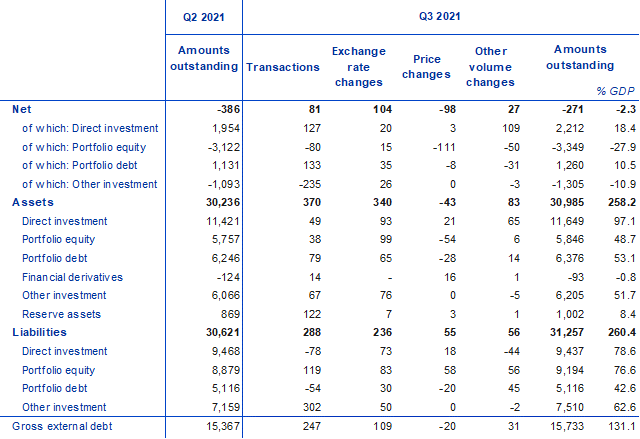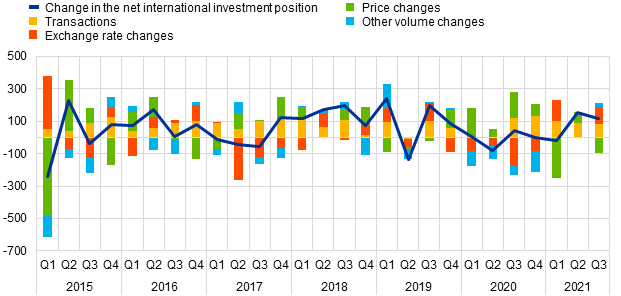- STATISTICAL RELEASE
Euro area quarterly balance of payments and international investment position:
third quarter of 2021
11 January 2022
- Current account surplus at €333 billion (2.8% of euro area GDP) in four quarters to third quarter of 2021, up from €180 billion (1.6% of GDP) a year earlier
- Geographic counterparts: largest bilateral current account surpluses vis-à-vis United Kingdom (€175 billion) and Switzerland (€76 billion), largest deficit vis-à-vis China (€69 billion)
- International investment position showed net liabilities of €271 billion (2.3% of euro area GDP) at end of third quarter of 2021
Current account
The current account surplus of the euro area increased to €333 billion (2.8% of euro area GDP) in the four quarters to the third quarter of 2021, up from €180 billion (1.6% of GDP) a year earlier (Table 1). This increase reflected a shift in the services balance from a deficit of €45 billion to a surplus of €91 billion, a larger surplus for goods (from €320 billion to €360 billion) and slightly larger surplus for primary income (from €50 billion to €52 billion). These developments were partly offset by a larger deficit for secondary income (from €146 billion to €169 billion).
The developments in services were mainly due to a reduction in the deficit for other business services (from €165 billion to €32 billion) and, to a lesser extent, an increase in the surpluses for telecommunication, computer and information services (from €95 billion to €121 billion) and transport services (from €10 billion to €19 billion). Conversely, the deficit for other services increased (from €15 billion to €41 billion) and a lower surplus was recorded for insurance, pension and financial services (from €16 billion to €10 billion).
The slight increase in the primary income surplus was driven by a larger surplus for investment income (from €21 billion to €25 billion). This primarily reflected a smaller deficit for portfolio equity income (down from €78 billion to €62 billion), and larger surpluses for portfolio debt income (up from €41 billion to €49 billion) and other investment income (up from €7 billion to €14 billion). These increases were partly offset by a lower surplus for direct investment income (down from €46 billion to €20 billion).
Table 1
Current account of the euro area
(EUR billions, unless otherwise indicated; transactions during the period; non-working day and non-seasonally adjusted)

Source: ECB.
Notes: “Equity” comprises equity and investment fund shares. Discrepancies between totals and their components may arise from rounding.
Data on the geographic counterparts of the euro area current account (Chart 1) show that in the four quarters to the third quarter of 2021 the euro area recorded its largest bilateral surpluses vis-à-vis the United Kingdom (€175 billion, up from €165 billion a year earlier), Switzerland (€76 billion, up from €56 billion) and the United States (€61 billion, down from €85 billion). It also recorded a current account surplus vis-à-vis a residual group of other countries (€168 billion, up from €162 billion). The largest bilateral deficits were recorded vis-à-vis China (€69 billion, down from €80 billion), EU Member States and EU institutions outside the euro area (€53 billion, up from €25 billion) and offshore centres (€24 billion, down from €175 billion).
The most significant geographic changes in the four quarters to the third quarter of 2021 relative to the previous year in the components of the current account were as follows. In the goods balance there were increases in the surpluses vis-à-vis the United States (from €157 billion to €183 billion) and the United Kingdom (from €97 billion to €110 billion), while the surplus vis-à-vis the residual group of other countries decreased (from €67 billion to €51 billion). In services the deficit vis-à-vis offshore centres declined strongly (from €152 billion to €16 billion) and the surplus vis-à-vis the residual group of other countries increased (from €68 billion to €94 billion), while the deficit vis-à-vis the United States increased (from €61 billion to €101 billion). In primary income, a larger deficit was recorded vis-à-vis the United States (from €9 billion to €21 billion), while the surplus vis-à-vis Switzerland increased (from €11 billion to €21 billion). In secondary income the deficit vis-à-vis the EU Member States and EU institutions outside the euro area widened from €80 billion to €103 billion, driven by euro area governments’ contributions to the EU budget.
Chart 1
Geographical breakdown of the euro area current account balance
(four-quarter moving sums in EUR billions; non-seasonally adjusted)

Source: ECB.
Note: “EU non-EA” comprises the non-euro area EU Member States and those EU institutions and bodies that are considered for statistical purposes as being outside the euro area, such as the European Commission and the European Investment Bank. “Other countries” includes all countries and country groups not shown in the chart, as well as unallocated transactions.
International investment position
At the end of the third quarter of 2021 the international investment position of the euro area recorded net liabilities of €271 billion vis-à-vis the rest of the world (2.3% of euro area GDP), decreasing from €386 billion in the previous quarter (Chart 2 and Table 2).
Chart 2
Net international investment position of the euro area
(net amounts outstanding at the end of the period as a percentage of four-quarter moving sums of GDP)

Source: ECB.
This decline in net liabilities of €114 billion reflected large but partly offsetting changes in the various investment components. Larger net assets were recorded for direct investment (€2,212 billion, up from €1,954 billion) and portfolio debt (€1,260 billion, up from €1,131 billion), while net liabilities increased in portfolio equity (€3,349 billion, up from €3,122 billion) and other investment (€1,305 billion, up from €1,093 billion).
Table 2
International investment position of the euro area
(EUR billions, unless otherwise indicated; amounts outstanding at the end of the period, flows during the period; non-working day and non-seasonally adjusted)

Source: ECB.
Notes: “Equity” comprises equity and investment fund shares. Net financial derivatives are reported under assets. Discrepancies between totals and their components may arise from rounding.
The developments in the euro area’s net international investment position in the third quarter of 2021 were mainly driven by positive net flows owing to transactions and exchange rate changes, which were partly offset by negative net price changes (Table 2 and Chart 3).
The increase in net assets for direct investment was due to a combination of positive net flows in transactions, exchange rate changes, price changes and other volume changes (Table 2), while the increase in net assets for portfolio debt was mainly driven by positive net flows in transactions and exchange rate changes. Larger net liabilities for portfolio equity and other investment were largely driven by negative net transactions, which for portfolio equity were compounded by negative net flows owing to price changes and other volume changes.
At the end of the third quarter of 2021 the gross external debt of the euro area amounted to €15.7 trillion (around 131% of euro area GDP), up by €366 billion compared with the previous quarter.
Chart 3
Changes in the net international investment position of the euro area
(EUR billions; flows during the period)

Source: ECB.
Note: “Other volume changes” mainly reflect reclassifications and data enhancements.
Data revisions
This statistical release incorporates revisions to data for the reference periods between the first quarter of 2018 and the second quarter of 2021. The revisions reflect revised national contributions to the euro area aggregates as a result of the incorporation of newly available information. In particular, data on portfolio investment were significantly revised, with a positive impact on the euro area net international investment position as of the first quarter of 2018.
Next releases
- Monthly balance of payments: 19 January 2022 (reference data up to November 2021)
- Quarterly balance of payments and international investment position: 5 April 2022 (reference data up to the fourth quarter of 2021)
For queries, please use the Statistical information request form.
Notes
- All data are neither seasonally nor working day-adjusted. Ratios to GDP (including in the charts) refer to four-quarter sums of non-seasonally and non-working day-adjusted GDP figures.
- Hyperlinks in this press release lead to data that may change with subsequent releases as a result of revisions.


